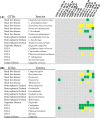Belowground microbiota analysis indicates that Fusarium spp. exacerbate grapevine trunk disease
- PMID: 37013554
- PMCID: PMC10071613
- DOI: 10.1186/s40793-023-00490-0
Belowground microbiota analysis indicates that Fusarium spp. exacerbate grapevine trunk disease
Abstract
Background: Grapevine trunk diseases (GTDs) are disease complexes that are major threats to viticulture in most grapevine growing regions. The microbiomes colonizing plant belowground components form complex associations with plants, play important roles in promoting plant productivity and health in natural environments, and may be related to GTD development. To investigate associations between belowground fungal communities and GTD symptomatic or asymptomatic grapevines, fungal communities associated with three soil-plant compartments (bulk soils, rhizospheres, and roots) were characterized by ITS high-throughput amplicon sequencing across two years.
Results: The fungal community diversity and composition differs according to the soil-plant compartment type (PERMANOVA, p < 0.001, 12.04% of variation explained) and sampling year (PERMANOVA, p < 0.001, 8.83%), whereas GTD symptomatology exhibited a weaker, but still significant association (PERMANOVA, p < 0.001, 1.29%). The effects of the latter were particularly prominent in root and rhizosphere community comparisons. Many GTD-associated pathogens were detected, but their relative abundances were not correlated (or were negatively correlated) to symptomatology. Fusarium spp., were enriched in symptomatic roots and rhizospheres compared to asymptomatic counterparts, suggesting that their abundances were positively correlated with symptomatic vines. Inoculation tests revealed that Fusarium isolates, similar to Dactylonectria macrodidyma, a pathogen associated with black foot disease, caused dark brown necrotic spots on stems in addition to root rot, which blackened lateral roots. Disease indices were higher with co-inoculation than single inoculation with a Fusarium isolate or D. macrodidyma, suggesting that Fusarium spp. can exacerbate disease severity when inoculated with other known GTD-associated pathogens.
Conclusions: The belowground fungal microbiota of grapevines varied from soil-plant compartments, the years and whether showed GTD symptoms. The GTDs symptoms were related to the enrichment of Fusarium spp. rather than the relative abundances of GTD pathogens. These results demonstrate the effects of fungal microbiota of roots and rhizospheres on GTDs, while providing new insights into opportunistic pathogenesis of GTDs and potential control practices.
Keywords: Belowground; Fungi; Fusarium spp.; Grapevine trunk diseases; Microbiota.
© 2023. The Author(s).
Conflict of interest statement
The authors declare no conflict of interest.
Figures







References
-
- Ye Q, Li Y, Zhou Y, Li X, Zhang W, Sun Q, et al. Occurrence of grapevine trunk diseases caused by fungal pathogens in the domestic and overseas. J Fruit Sci. 2021;38(02):278–292.
-
- Romanazzi G, Murolo S, Pizzichini L, Nardi S. Esca in young and mature vineyards, and molecular diagnosis of the associated fungi. Eur J Plant Pathol. 2009;125(2):277–290. doi: 10.1007/s10658-009-9481-8. - DOI
-
- Chamberlain GC, Willison RS, Townshend JL, Ronde JHD. Two fungi associated with the dead-arm disease of grapes. Can J Bot. 1964;42(4):351–355. doi: 10.1139/b64-034. - DOI
-
- Carter MV, Price TV. Eutypa Armeniacae associated with vascular disease in grapevine and barberry. Aust Plant Pathol Soc Newsl. 1973;2(4):27. doi: 10.1071/APP9730027. - DOI
-
- Niekerk J, Groenewald JZ, Farr DF, Fourie PH, Halleer F, Crous PW. Reassessment of Phomopsis species on grapevines. Australas Plant Path. 2005;34(1):27–39. doi: 10.1071/AP04072. - DOI
Grants and funding
LinkOut - more resources
Full Text Sources
Miscellaneous
